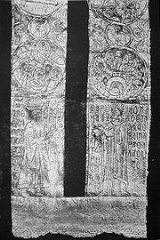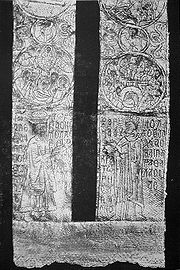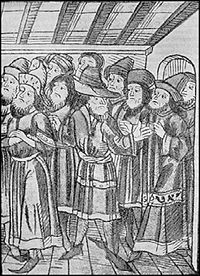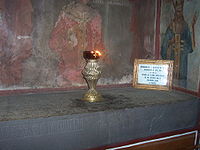
Alexandru cel Bun
Encyclopedia

Moldavia
Moldavia is a geographic and historical region and former principality in Eastern Europe, corresponding to the territory between the Eastern Carpathians and the Dniester river...
, reigning between 1400 and 1432, son of Roman I Mușat
Roman I of Moldavia
Roman I was Voivode of Moldavia from December 1391 to March 1394. He was the second son of Costea Muşat, the first ruler from the Muşatin family....
. He succeeded Iuga
Iuga of Moldavia
Iuga of Moldavia was Voivode of Moldavia from November 1399 to June 1400. He was son of Roman I of Moldavia and an unknown wife, possibly of Lithuanian extraction from descendants of Karijotas...
to the throne, and, as a ruler, initiated a series of reforms while consolidating the status of the Moldavian Principality.
Internal politics

Bureaucracy
A bureaucracy is an organization of non-elected officials of a governmental or organization who implement the rules, laws, and functions of their institution, and are occasionally characterized by officialism and red tape.-Weberian bureaucracy:...
system by creating the "Council of the Voivode", the Chancellor
Chancellor
Chancellor is the title of various official positions in the governments of many nations. The original chancellors were the Cancellarii of Roman courts of justice—ushers who sat at the cancelli or lattice work screens of a basilica or law court, which separated the judge and counsel from the...
y and by adding (in 1403) the institution of Logofăt – Chancellor of the official Chancellery.
During his reign, he introduced new fiscal laws, by adding commercial privilege
Privilege
A privilege is a special entitlement to immunity granted by the state or another authority to a restricted group, either by birth or on a conditional basis. It can be revoked in certain circumstances. In modern democratic states, a privilege is conditional and granted only after birth...
s to the traders of Lviv
Lviv
Lviv is a city in western Ukraine. The city is regarded as one of the main cultural centres of today's Ukraine and historically has also been a major Polish and Jewish cultural center, as Poles and Jews were the two main ethnicities of the city until the outbreak of World War II and the following...
(1408) and Kraków
Kraków
Kraków also Krakow, or Cracow , is the second largest and one of the oldest cities in Poland. Situated on the Vistula River in the Lesser Poland region, the city dates back to the 7th century. Kraków has traditionally been one of the leading centres of Polish academic, cultural, and artistic life...
(1409), improved the situation of the trading routes (especially the one linking the port of Cetatea Albă to Poland), strengthened the forts guarding them, and expanded the Moldavian ports of Cetatea Albă and Chilia
Kilia
Kilia may refer to:* Kilia, a town in Ukraine* Chilia Veche, a town in Tulcea County, Romania* Chilia branch, a distributary of the Danube.* 470 Kilia, an asteroid.* Kilia, an English transliteration of Χηλή, the Greek name for the town of Şile in Turkey...
.
He also had a role in ending the conflict of the Moldavian Eastern Orthodox
Eastern Orthodox Church
The Orthodox Church, officially called the Orthodox Catholic Church and commonly referred to as the Eastern Orthodox Church, is the second largest Christian denomination in the world, with an estimated 300 million adherents mainly in the countries of Belarus, Bulgaria, Cyprus, Georgia, Greece,...
with the Patriarch of Constantinople
Patriarch of Constantinople
The Ecumenical Patriarch is the Archbishop of Constantinople – New Rome – ranking as primus inter pares in the Eastern Orthodox communion, which is seen by followers as the One, Holy, Catholic, and Apostolic Church....
; he built Bistrița Monastery
Bistrita Monastery
The Bistriţa Monastery is a Romanian Orthodox monastery located 8 km west of Piatra Neamţ. It was dedicated in 1402 by Romanian Voivode Alexandru cel Bun whose remains are buried here....
where he is buried and continued the building of Neamț Monastery
Neamt Monastery
The Neamţ Monastery is a Romanian Orthodox religious settlement, one of the oldest and most important of its kind in Romania. It was built in 14th century, and it is an example of medieval Moldavian architecture...
which was started in the previous century.
Foreign affairs
The main concern of Alexander the Good was to defend the country in wars against superior armies. In order to do that, he forged a system of alliances with WallachiaWallachia
Wallachia or Walachia is a historical and geographical region of Romania. It is situated north of the Danube and south of the Southern Carpathians...
and Poland, generally against Hungary
Kingdom of Hungary
The Kingdom of Hungary comprised present-day Hungary, Slovakia and Croatia , Transylvania , Carpatho Ruthenia , Vojvodina , Burgenland , and other smaller territories surrounding present-day Hungary's borders...
(although he had been backed to the throne by Sigismund of Hungary
Sigismund, Holy Roman Emperor
Sigismund of Luxemburg KG was King of Hungary, of Croatia from 1387 to 1437, of Bohemia from 1419, and Holy Roman Emperor for four years from 1433 until 1437, the last Emperor of the House of Luxemburg. He was also King of Italy from 1431, and of Germany from 1411...
). In 1402, he was sworn vassal
Vassal
A vassal or feudatory is a person who has entered into a mutual obligation to a lord or monarch in the context of the feudal system in medieval Europe. The obligations often included military support and mutual protection, in exchange for certain privileges, usually including the grant of land held...
of Jogaila
Jogaila
Jogaila, later 'He is known under a number of names: ; ; . See also: Jogaila : names and titles. was Grand Duke of Lithuania , king consort of Kingdom of Poland , and sole King of Poland . He ruled in Lithuania from 1377, at first with his uncle Kęstutis...
, the King of Poland. The treaty was renewed in 1404, 1407, 1411 and 1415.
Alexander participated in two battles against the Teutonic Knights
Teutonic Knights
The Order of Brothers of the German House of Saint Mary in Jerusalem , commonly the Teutonic Order , is a German medieval military order, in modern times a purely religious Catholic order...
: in 1410 at Grunwald
Battle of Grunwald
The Battle of Grunwald or 1st Battle of Tannenberg was fought on 15 July 1410, during the Polish–Lithuanian–Teutonic War. The alliance of the Kingdom of Poland and the Grand Duchy of Lithuania, led respectively by King Jogaila and Grand Duke Vytautas , decisively defeated the Teutonic Knights, led...
and in 1422 at Marienburg
Siege of Marienburg (1410)
The Siege of Marienburg was an unsuccessful two-month siege of the castle in Marienburg , the capital of the monastic state of the Teutonic Knights...
. In 1420, he also defended Moldavia against the first incursion by Ottomans
Ottoman Empire
The Ottoman EmpireIt was usually referred to as the "Ottoman Empire", the "Turkish Empire", the "Ottoman Caliphate" or more commonly "Turkey" by its contemporaries...
at Cetatea Albă. He also got involved in the power struggles of Wallachia, by helping Radu II Prasnaglava in 1418–1419 and Alexandru I Aldea
Alexandru I Aldea
Alexander I Aldea was Prince of Wallachia .Alexandru I was the brother of Vlad II Dracul, father to Mircea II and Vlad Tepes . He came to rule Wallachia during an extremely turbulent time, when rule of the country changed hands by violence eighteen times during the 15th century...
in 1429, mostly in order to prevent the capture of Chilia.
Due to a territorial claim of Poland and the previous failure of the Polish king to fulfill his part of the vassality treaty during an Ottoman
Ottoman Empire
The Ottoman EmpireIt was usually referred to as the "Ottoman Empire", the "Turkish Empire", the "Ottoman Caliphate" or more commonly "Turkey" by its contemporaries...
attack in 1420, Alexander launched an attack on Poland during the Lithuanian Civil War (1431–1435). The attack ended with the treaty of Suceava
Suceava
Suceava is the Suceava County seat in Bukovina, Moldavia region, in north-eastern Romania. The city was the capital of the Principality of Moldavia from 1388 to 1565.-History:...
on November 18, 1431.
Personal life

Rymgajla
Rymgajla was daughter of Birutė and Kęstutis, Grand Duke of Lithuania, and thus sister of Vytautas the Great. Rimgailė is a typical dual-stemmed pagan Lithuanian name constructed from rim- + gail- , which is quite common in Lithuania at present.By marriage with Henry of Masovia, she was Princess of...
(daughter of Kęstutis
Kestutis
Kęstutis was monarch of medieval Lithuania. He was the Duke of Trakai and governed the Grand Duchy of Lithuania, 1342–82, together with his brother Algirdas , and with his nephew Jogaila...
and sister of Vytautas the Great
Vytautas the Great
Vytautas ; styled "the Great" from the 15th century onwards; c. 1350 October 27, 1430) was one of the most famous rulers of medieval Lithuania. Vytautas was the ruler of the Grand Duchy of Lithuania which chiefly encompassed the Lithuanians and Ruthenians...
of Lithuania
Grand Duchy of Lithuania
The Grand Duchy of Lithuania was a European state from the 12th /13th century until 1569 and then as a constituent part of Polish-Lithuanian Commonwealth until 1791 when Constitution of May 3, 1791 abolished it in favor of unitary state. It was founded by the Lithuanians, one of the polytheistic...
; divorced in 1421), and Mariana – and at least three concubines. He had twenty-four sons (including illegitimate) – six of them later reigning in Moldavia
Moldavia
Moldavia is a geographic and historical region and former principality in Eastern Europe, corresponding to the territory between the Eastern Carpathians and the Dniester river...
– and seventeen daughters. He was father-in-law to Vlad II Dracul
Vlad II Dracul
Vlad II , known as Vlad Dracul , was a voivode of Wallachia. He reigned from 1436 to 1442, and again from 1443 to 1447...
and grandfather to Vlad III the Impaler
Vlad III the Impaler
Vlad III, Prince of Wallachia , also known by his patronymic Dracula , and posthumously dubbed Vlad the Impaler , was a three-time Voivode of Wallachia, ruling mainly from 1456 to 1462, the period of the incipient Ottoman conquest of the Balkans...
through his eldest daughter, Cneajna.
He died on January 1, 1432, and was buried in the Bistriţa Monastery.

